Despite the prevalence of electronic navigation systems, road signs remain important. For one thing, positioning is sometimes not precise enough in complex intersections. For another, they help verify virtual directions (navigation system) against real-world conditions (signs). Currently, the German signposting guidelines (RWB – Richtlinien für wegweisende Beschilderung) stipulate the so-called 4/10 rule, which means that one sign can display a maximum of 10 destinations in total and a maximum of 4 per direction on the kind of yellow signs posted along most roads other than freeways. This rule is based on theoretical and practical considerations.
Example of the 4/10 Rule
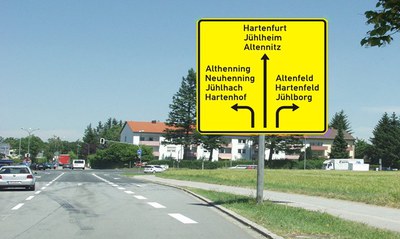
Increases in traffic and road network density raise a number of questions.
- How much time do drivers have to read signs?
- How much information should be displayed on a sign so that it can be read and processed safely without negatively affecting traffic?
- Can the number of destinations displayed on a sign be increased by using pictograms?
To answer these questions, a field trial was conducted which involved eye tracking while signs were read on freeways, highways and urban roads.
The average time available to read signs on freeways is:
- 5.4 seconds for overhead signs,
- 4.2 seconds for signs on the side of the road.
The average time available to read signs on country roads and urban roads is 3.0 seconds.
Designing Signs
Based on the time available for reading signs (5.4, 4.2 or 3.0 seconds), design proposals were developed in several laboratory and field trials.
Recommendation for freeways:
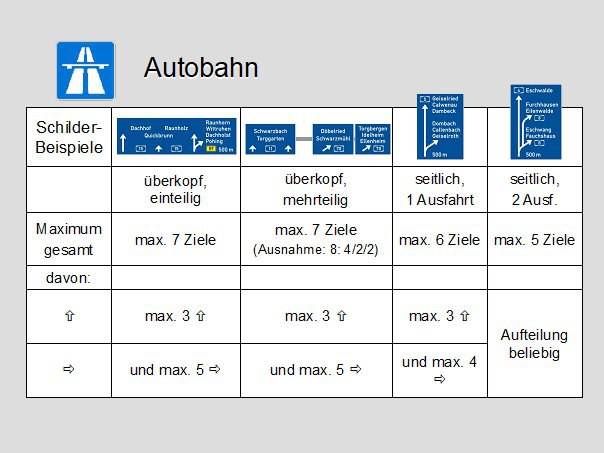
Recommendation for country roads:
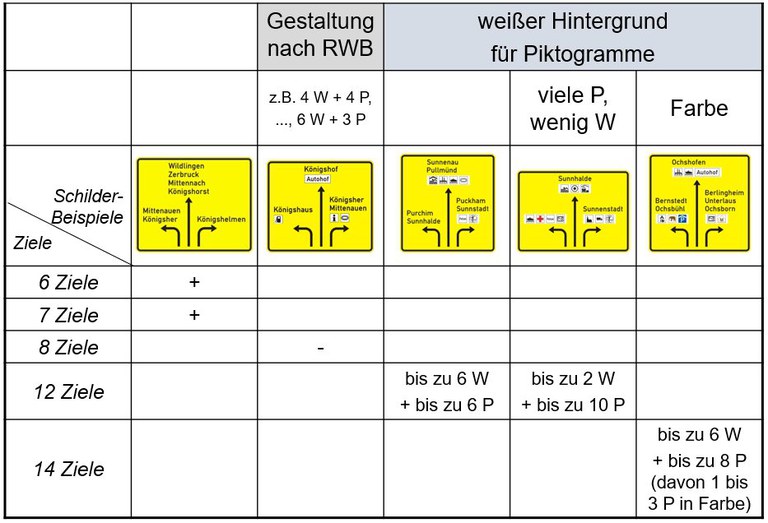
Literature
Färber, Berthold: Zielführung oder Verwirrung durch wegweisende Beschilderung?
In: 7. Deutscher Straßenausstattertag in Bremen, 18.-19. März 2015. - S. 26-27. Bonn: Kirschbaumverlag.
Variable direction signs:
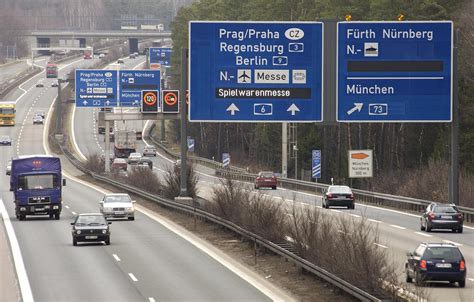
A further question concerns the design of so-called variable direction signs. They are used for dynamic traffic management in traffic jams, but also for targeted traffic guidance at trade fairs or other major events. Arrow-oriented and freely programmable signs with and without detour recommendation were investigated.
The tests took place in the laboratory. The pictures show examples of the two sign variants and the test setup.
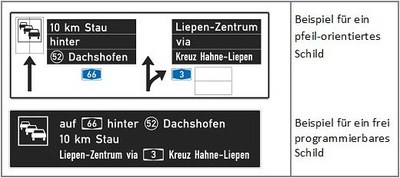
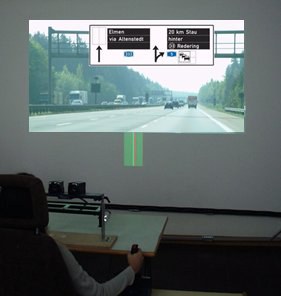
Test setup with gaze registration, follow-up tracking task and an arrow-oriented sign variant.
Results
- With arrow-oriented signs, significantly more correct route decisions are made. "Correct decision" means that the driver uses the alternative route if he is affected by the traffic jam. Otherwise he stays on the normal route.
- Arrow-oriented signs support people with less knowledge of the area more. They are more likely to recognize the direction of the detour recommendation than signs without arrows. They thus help to compensate for a certain degree of uncertainty when choosing a route.
- For signs without detour recommendation and simple detour instructions (e.g. "via A3"), arrow-oriented signs perform significantly better.
- In addition to detour recommendations using the delestage arrow, "via + location information" is also highly recommended.
Literature
Färber, Berthold; Färber, Brigitte: Akzeptanz von Wechselverkehrszeichen im Einsatz von SBA.
In: Steinhoff, Christiane; Kates, Roland; Keller, Hartmut; Färber, Berthold; Färber, Brigitte: Problematik präventiver Schaltungen von Streckenbeeinflussungsanlagen. Forschung Straßenbau und Straßenverkehrstechnik, Heft 853, 2002, - S. 91-110. Hrsg. Bundesministerium für Verkehr, Bau- und Wohnungswesen, Abteilung Straßenbau, Straßenverkehr. Bonn: DMB Bundesdruckerei.